Some of the information on this Web page has been provided by external sources. The Government of Canada is not responsible for the accuracy, reliability or currency of the information supplied by external sources. Users wishing to rely upon this information should consult directly with the source of the information. Content provided by external sources is not subject to official languages, privacy and accessibility requirements.
Any discrepancies in the text and image of the Claims and Abstract are due to differing posting times. Text of the Claims and Abstract are posted:
| (12) Patent: | (11) CA 2442672 |
|---|---|
| (54) English Title: | LINEAR FLUORESCENT LAMP END CAP LOCKING SYSTEM |
| (54) French Title: | SYSTEME DE VERROUILLAGE DE CULOT DE LAMPE FLUORESCENTE LINEAIRE |
| Status: | Deemed expired |
| (51) International Patent Classification (IPC): |
|
|---|---|
| (72) Inventors : |
|
| (73) Owners : |
|
| (71) Applicants : |
|
| (74) Agent: | FETHERSTONHAUGH & CO. |
| (74) Associate agent: | |
| (45) Issued: | 2007-07-31 |
| (22) Filed Date: | 2003-09-25 |
| (41) Open to Public Inspection: | 2004-05-27 |
| Examination requested: | 2003-10-10 |
| Availability of licence: | N/A |
| (25) Language of filing: | English |
| Patent Cooperation Treaty (PCT): | No |
|---|
| (30) Application Priority Data: | |||||||||
|---|---|---|---|---|---|---|---|---|---|
|
A locking system for two linear fluorescent lamps comprises an endcap formed to receive two linear fluorescent lamps (Fig. 3). The endcap has two chambers formed by the outside surfaces of endcap and a central partition. Each of the chambers has a forward portion and a rearward portion. The endcap has a height H equal to the diameter of the fluorescent lamps, a width W equal to twice the diameter of the fluorescent lamps and a length, for example, 4 to 6 inches, that is substantially less than the length of the lamps, which can be one to eight feet long. A stop is formed in each of the chambers at the forward portion to retain the lamps within the endcap. Each of the stops, in the form of a reverse corner, extends inwardly toward the center of the endcap and has a first panel with a first dimension equal to the height H and a second panel with a second dimension that is greater than one half of said height H but less than the height H.
Un système de verrouillage de deux lampes fluorescentes linéaires comprend un embout formé pour recevoir les deux lampes fluorescentes linéaires (Fig. 3). L'embout est doté de deux chambres formées par les surfaces extérieures de l'embout et une portion centrale. Chacune des chambres comporte une partie avant et une partie arrière. L'embout a une hauteur H égale au diamètre des lampes fluorescentes, une largeur W égale à deux fois le diamètre des lampes fluorescentes et une longueur, par exemple, de 4 à 6 pouces, qui est substantiellement inférieure à la longueur des lampes, qui peut être de un à huit pieds. Une butée est formée dans chacune des chambres à la portion avant pour retenir les lampes dans l'embout. Chacune des butées, ayant la forme d'un coin inversé, s'étend à l'intérieur vers le centre de l'embout et un premier panneau ayant une première dimension également à la hauteur H et un deuxième panneau ayant une deuxième dimension qui est plus grande que la moitié de ladite hauteur H mais moins que la hauteur H.
Note: Claims are shown in the official language in which they were submitted.
Note: Descriptions are shown in the official language in which they were submitted.

For a clearer understanding of the status of the application/patent presented on this page, the site Disclaimer , as well as the definitions for Patent , Administrative Status , Maintenance Fee and Payment History should be consulted.
| Title | Date |
|---|---|
| Forecasted Issue Date | 2007-07-31 |
| (22) Filed | 2003-09-25 |
| Examination Requested | 2003-10-10 |
| (41) Open to Public Inspection | 2004-05-27 |
| (45) Issued | 2007-07-31 |
| Deemed Expired | 2014-09-25 |
There is no abandonment history.
| Fee Type | Anniversary Year | Due Date | Amount Paid | Paid Date |
|---|---|---|---|---|
| Registration of a document - section 124 | $100.00 | 2003-09-25 | ||
| Application Fee | $300.00 | 2003-09-25 | ||
| Request for Examination | $400.00 | 2003-10-10 | ||
| Maintenance Fee - Application - New Act | 2 | 2005-09-26 | $100.00 | 2005-09-01 |
| Maintenance Fee - Application - New Act | 3 | 2006-09-25 | $100.00 | 2006-08-18 |
| Final Fee | $300.00 | 2007-05-10 | ||
| Maintenance Fee - Patent - New Act | 4 | 2007-09-25 | $100.00 | 2007-08-17 |
| Maintenance Fee - Patent - New Act | 5 | 2008-09-25 | $200.00 | 2008-08-19 |
| Maintenance Fee - Patent - New Act | 6 | 2009-09-25 | $200.00 | 2009-08-12 |
| Maintenance Fee - Patent - New Act | 7 | 2010-09-27 | $200.00 | 2010-08-20 |
| Registration of a document - section 124 | $100.00 | 2011-04-15 | ||
| Maintenance Fee - Patent - New Act | 8 | 2011-09-26 | $200.00 | 2011-08-09 |
| Maintenance Fee - Patent - New Act | 9 | 2012-09-25 | $200.00 | 2012-08-13 |
Note: Records showing the ownership history in alphabetical order.
| Current Owners on Record |
|---|
| OSRAM SYLVANIA INC. |
| Past Owners on Record |
|---|
| HARDY, GREGORY J. |
| OSRAM SYLVANIA INC. |